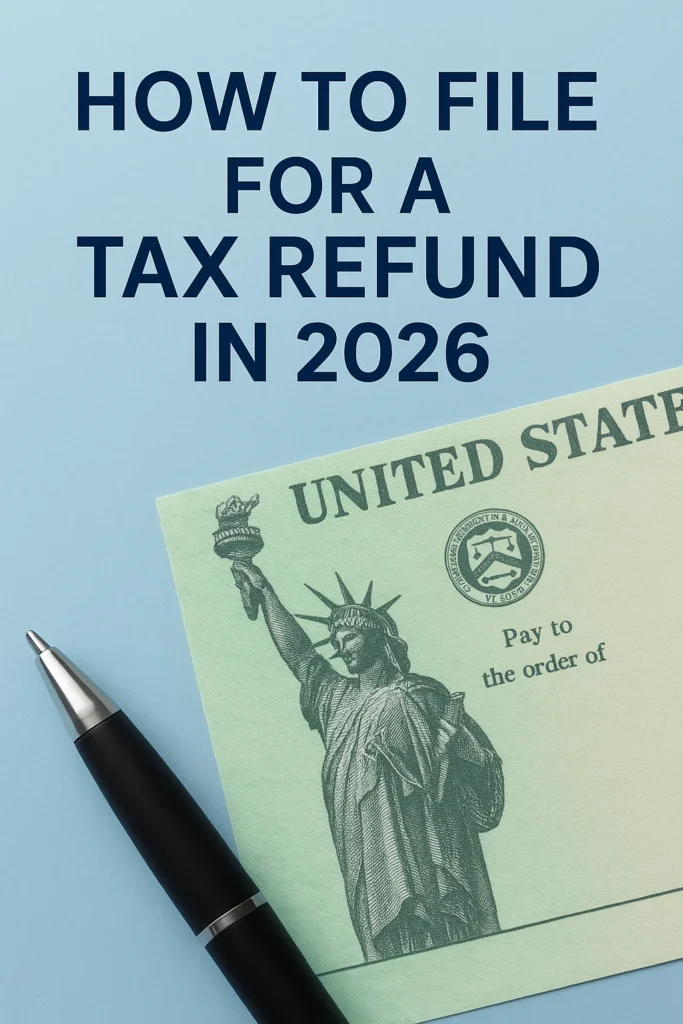Every year, millions of Americans file their federal income taxes, and a majority receive refunds. In 2025, IRS data showed that over 62% of taxpayers qualified for a refund, with the average amount exceeding $3,300. With the 2026 tax season approaching, understanding how to file correctly is essential for securing your refund without unnecessary delays.
This guide provides a step-by-step explanation of how to file for a tax refund in 2026 in the United States, including required documents, IRS systems, timelines, common pitfalls, and strategies to maximize accuracy.
What Is a Tax Refund?
A tax refund occurs when the IRS determines you have paid more taxes during the year than required, often through employer withholdings or estimated payments. The IRS issues a refund after processing your annual tax return (Form 1040). Refunds are not a “bonus”; they represent overpayment of taxes.
Key Refund Sources:
- W-2 employees: Excess withheld from paychecks.
- Self-employed individuals: Overpayment via estimated quarterly taxes.
- Tax credits: Earned Income Tax Credit (EITC), Child Tax Credit, and energy-related credits can increase refunds.
When Can You File for a Tax Refund in 2026?
- IRS Filing Season Opens: Historically in late January. The official start date for 2026 will be announced in early January by the IRS.
- Filing Deadline: Expected to be April 15, 2026, unless extended for holidays or special circumstances.
- Extension Deadline: Taxpayers filing Form 4868 can receive an extension until October 15, 2026, though refunds are only processed after filing the return itself.
Step-by-Step Process for Filing a Tax Refund
Step 1: Gather Documentation
- W-2 forms (employment income)
- 1099 forms (freelance income, dividends, interest, gig work)
- 1098 forms (mortgage interest, tuition payments)
- Receipts for deductible expenses (charitable donations, business expenses)
- Social Security numbers for all dependents
Step 2: Choose Filing Method
- E-file through IRS Free File or commercial software: Fastest and most reliable.
- Hire a tax professional/CPA: Recommended for complex situations.
- Paper filing (Form 1040 by mail): Strongly discouraged due to delays refunds may take 12 weeks or longer.
Step 3: Complete Your Return
Ensure accuracy in:
- Income reporting
- Deduction claims
- Tax credit eligibility
- Banking details for direct deposit
Step 4: Submit to the IRS
- E-file + Direct Deposit = fastest refunds (within ~21 days).
- Paper returns or mailed refund checks = slowest, often 8–12 weeks.
Step 5: Track Your Refund
- IRS “Where’s My Refund?” Tool: Available on IRS.gov and the IRS2Go mobile app.
- Information updated daily, usually overnight.
Refund Timelines in 2026
- Direct deposit refunds: Typically within 21 days of IRS acceptance.
- Paper checks: Can take 6-12 weeks.
- Delays may occur if:
- There are errors in Social Security numbers or banking details.
- The taxpayer claims the EITC or Additional Child Tax Credit (ACTC). Federal law requires holding these refunds until mid-February to prevent fraud.
- IRS requires identity verification.
Common Errors That Delay Refunds
- Entering incorrect bank routing or account numbers.
- Mistakes in dependent information.
- Forgetting to sign the paper return.
- Mismatches with W-2/1099 forms reported by employers.
- Claiming ineligible credits.
Special Cases in 2026
a. Amended Returns (Form 1040-X)
If you discover errors after filing, you must submit an amended return. Refunds from amended returns may take 16 weeks or longer.
b. Identity Theft Cases
If flagged for identity verification, taxpayers must use IRS Identity Verification Service. Refunds are held until completion of verification.
c. Direct File Pilot Expansion
In 2026, the IRS plans to expand its Direct File program, allowing eligible taxpayers to file returns directly with the IRS online. Adoption of this system could streamline refunds for millions of filers.
Strategies to Maximize Refund Efficiency
- File Early: Filing in January or February reduces risk of delays and identity theft.
- Use Direct Deposit: Splitting your refund across up to three accounts is possible, providing faster access and better money management.
- Verify All Forms: Match reported income with IRS records to avoid red flags.
- Leverage Tax Credits: Credits such as the Earned Income Tax Credit, American Opportunity Credit (education), and Clean Vehicle Credit can significantly boost refunds.
After Receiving Your Refund
- Emergency Fund: Build 3–6 months of living expenses.
- Debt Repayment: High-interest credit cards should be prioritized.
- Retirement Savings: Contribute to IRAs or 401(k)s for tax advantages.
- Education Savings: 529 plans for children’s education.
- Energy Upgrades: Certain home improvements can generate additional tax credits in future years.
State Refunds vs. Federal Refunds
While this guide covers federal refunds, many states also issue refunds.
- State deadlines often align with the IRS but vary (e.g., Massachusetts and Maine deadlines adjust for Patriots’ Day).
- Taxpayers must file both federal and state returns where applicable.
Key Takeaways for 2026 Refund Season
- Most refunds are issued within 21 days of IRS acceptance when e-filing with direct deposit.
- Errors, credits, and paper filing cause the majority of delays.
- Refunds represent repayment of overpaid taxes not a bonus so adjusting your withholdings may prevent overpayments in future years.
- Filing early, maintaining accurate records, and using official IRS tools ensures smoother processing.
Conclusion
Navigating tax refunds in 2026 requires preparation, attention to detail, and awareness of IRS systems. By filing early, opting for direct deposit, and verifying your return, you can minimize delays and receive your refund promptly. Tax refunds remain one of the most anticipated financial events for U.S. households, and understanding the process is the key to maximizing its benefits.

